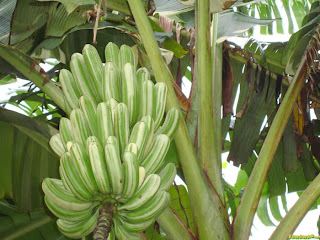Let me start with a joke. A traffic light can be considered the opposite of a banana. With a traffic light, green means go, yellow means wait, and red means stop. With a banana, green means wait, yellow means go, and red means - wait, where did you get that banana? This is funny because bananas aren’t red; some of you would argue that this isn’t funny at all, but that’s not the point. The point is that bananas aren’t red, right? Well...
A few weeks ago, I swore I’d stick with one botany post per week. This is a new week, and we’re going to delve into the wild world of the Musaceae. The Musaceae family is one of those big, tropical plant families that you don’t hear much about in the temperate climes, save a few overachieving members. In the case of this family, bananas and plantains are the overachievers. There are over one hundred Musaceae species, but the whole family gets called “banana”. Which isn’t really fair to the Manila hemp, now is it?
Still, if we’re going to judge an entire plant family by just a few of its constituent species, we should at least have a better appreciation for the sheer diversity of banana (and plantain) fruits. Readers from the tropics, a lot of this may be old hat to you, but we really don’t know much about bananas in the temperate regions. For most of us, our experience with these fruits (technically berries) is limited to one cultivar of banana, and maybe two cultivars of plantains. The banana you buy in the supermarket is almost guaranteed to be a Cavendish, the plantain is probably either a Bluggoe or a Pelipita. For the record, bananas are traditionally defined as sweet fruits from the Musa paradisiaca plant, while plantains are the starchier fruits of the Musa sapientum plant. Bananas can be eaten raw, plantains can be cooked. Of course, the distinction starts to break down, and there are other species of fruit banana out there, but that's the condensed version.
I could do this whole post on the story behind the dominance of those cultivars, but I’ll condense it to one paragraph. Others have written far more eloquently on the tale of the Cavendish banana, but let’s just say that the Cavendish banana grows quickly, is easy to ship, has a long shelf-life, and is resistant to a wide-spread banana disease. Prior to the 1950’s, the top banana was the Gros Michel cultivar, which was big, fast-growing, reasonably easy to ship, and really tasty. Unfortunately, it was not resistant to the aforementioned disease, the Panama fungus, and is now all-but-extinct. The Bluggoe and Pelipita plantain cultivars have a somewhat similar story - both grow quickly, ship well, and are resistant to Panama disease, as well as several other common banana diseases.
Over-exposure to just a handful of cultivars (and in the case of the Cavendish, not even particularly tasty cultivars) has left many of us blind to the incredible diversity of the banana family. Similarly, while plantains are increasingly familiar to Americans, many temperate regions still view the banana as a fruit crop, and not an overly important fruit crop - compare traditional American and European uses for the apple or the grape with uses for the banana. It’s different in the tropics, though. Bananas are a staple crop in many parts of the world, playing a role similar to that played by the potato in the Andes. In Uganda, for example, the average adult eats five pounds of bananas per day (and no, that does not include the skin). And, like most staple crops, there are varieties of bananas suited for different uses, growing cycles, and microclimates. Not to mention different taste preferences.
Not quite the local produce section, eh? There are bananas out there that are ripe when green, or orange, or maroon. There are striped bananas, and tiny bananas, and gigantic bananas. Bananas grown as staple crops in Ecuador are adopted to one microclimate and set of pests, while bananas grown as as staple crop in Ethiopia are adapted to completely different conditions.
All ripe! All of them!
This diversity is the secret to the success of the banana, and the key to preserving its future. There are a lot of microbes out there with the potential to wreck havoc on commerical banana production (remember the fate of the Gros Michel?). Places like Africa and Oceania are hot spots of banana cultivar diversity, and by extension, genetic diversity. While we in cooler climes eat just a few genetically identical cultivars, the rest of the world is growing bananas that are resistant to just about every banana pest and pathogen out there. True, there is no one banana that is resistant to everything, but do we really need that? In a world full of pink and stripey bananas, do we really need to only eat one boring kind? We should all embrace the diversity of the banana family, and if we’re going to insist on calling an entire botanical group by the common name of a handful of species, let’s at least see what that handful of species really has to offer.








So, after the Defense, will you be exposing your benighted parents to better bananas?
ReplyDelete